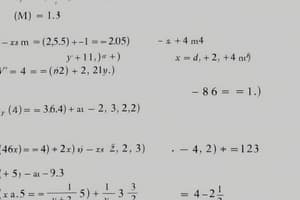Podcast
Questions and Answers
What does the 'tol' parameter represent in gradient descent algorithms?
What does the 'tol' parameter represent in gradient descent algorithms?
- The threshold for insignificant updates. (correct)
- The learning rate of the algorithm.
- The maximum number of iterations allowed.
- The initial value of the coefficients.
Which method is recommended for solving nonlinear regression problems due to the lack of a closed-form solution?
Which method is recommended for solving nonlinear regression problems due to the lack of a closed-form solution?
- Batch Gradient Descent
- Stochastic Gradient Descent (correct)
- Linear Regression
- Ridge Regression
What is a significant disadvantage of using the closed-form solution in linear regression?
What is a significant disadvantage of using the closed-form solution in linear regression?
- It's only applicable for small datasets. (correct)
- It cannot handle regularized versions of regression.
- The results are not deterministic.
- It requires a complex optimization algorithm.
In the context of gradient descent, what does a 'batch' approach entail?
In the context of gradient descent, what does a 'batch' approach entail?
Why is the SGDRegressor considered more flexible than LinearRegression?
Why is the SGDRegressor considered more flexible than LinearRegression?
What is a primary advantage of using feature scaling in linear regression analyses?
What is a primary advantage of using feature scaling in linear regression analyses?
What is the consequence of using a very large matrix for linear regression parameter estimation?
What is the consequence of using a very large matrix for linear regression parameter estimation?
What does the cost function measure in regression analysis?
What does the cost function measure in regression analysis?
What is the primary reason for scaling features before training a model?
What is the primary reason for scaling features before training a model?
What is the effect of using a learning rate that is too high in gradient descent?
What is the effect of using a learning rate that is too high in gradient descent?
Which of the following statements about standard scaling is true?
Which of the following statements about standard scaling is true?
In the context of multiple regression analysis, what is the primary role of the cost function?
In the context of multiple regression analysis, what is the primary role of the cost function?
During the gradient descent optimization process, what does the learning rate determine?
During the gradient descent optimization process, what does the learning rate determine?
What should NOT be done when scaling datasets for linear regression?
What should NOT be done when scaling datasets for linear regression?
How does NumPy vectorization affect the performance of gradient descent?
How does NumPy vectorization affect the performance of gradient descent?
What is a common practice when using a cost function in linear regression?
What is a common practice when using a cost function in linear regression?
What is a key advantage of using vectorization in NumPy for gradient descent?
What is a key advantage of using vectorization in NumPy for gradient descent?
In multiple linear regression, what does the term 'w' represent?
In multiple linear regression, what does the term 'w' represent?
Which of the following statements best describes the cost function in the context of gradient descent?
Which of the following statements best describes the cost function in the context of gradient descent?
In the context of gradient descent, what role does the learning rate play?
In the context of gradient descent, what role does the learning rate play?
What is the primary purpose of feature scaling in gradient descent?
What is the primary purpose of feature scaling in gradient descent?
In multiple linear regression, how is the model output computed using weights and features?
In multiple linear regression, how is the model output computed using weights and features?
Why is running gradient descent until convergence important?
Why is running gradient descent until convergence important?
In the context of multiple linear regression, what are the terms '𝜕𝐽/𝜕𝑤𝑗' and '𝜕𝐽/𝜕𝑏' used for?
In the context of multiple linear regression, what are the terms '𝜕𝐽/𝜕𝑤𝑗' and '𝜕𝐽/𝜕𝑏' used for?
Which of the following is a characteristic of the gradient descent algorithm?
Which of the following is a characteristic of the gradient descent algorithm?
How does regularization contribute to gradient descent in linear regression?
How does regularization contribute to gradient descent in linear regression?
Which of the following statements about the cost function is true?
Which of the following statements about the cost function is true?
What is the effect of choosing a learning rate that is too high in gradient descent?
What is the effect of choosing a learning rate that is too high in gradient descent?
In the equation of the model for multiple linear regression, what role does the term 'b' represent?
In the equation of the model for multiple linear regression, what role does the term 'b' represent?
Why is vectorization generally preferred over explicit for loops in implementations of gradient descent?
Why is vectorization generally preferred over explicit for loops in implementations of gradient descent?
Flashcards are hidden until you start studying
Study Notes
Standard Scaling
- Scaling is a transformation applied to both training and test data, ensuring consistent predictions.
- Standard scaling uses Z-score normalization, subtracting the mean and dividing by the standard deviation of each feature.
- For training data, the mean and standard deviation are calculated from the training set and applied to all instances.
- For test data, the mean and standard deviation are calculated from the training set, not the test set, and applied to all test instances.
- Scaler (e.g. StandardScaler in sklearn) should be fit to the training data and only transformed for the test data to avoid introducing bias.
Gradient Descent & Linear Regression
- Gradient descent is an iterative optimization algorithm used to find the optimal parameters (weights and bias) for a linear regression model.
- Learning rate (alpha) determines the step size in each iteration of gradient descent, typically ranging from 0.1 to 0.0001.
- Convergence is achieved when change in the cost function or coefficients falls below a specified threshold (tol).
- LinearRegression (sklearn) is a straightforward approach suitable for smaller datasets, while SGDRegressor (sklearn) is more scalable for large datasets and online learning but requires more parameter tuning.
- The closed-form solution is an analytical method for calculating parameters but is computationally demanding for large datasets and not always applicable for non-linear models.
Linear Regression with Multiple Variables (MLR)
- MLR is an extension of SLR, incorporating multiple features (variables) to predict an output.
- The model utilizes a linear combination of weights multiplied by feature values, plus a bias term.
- Vectorization in NumPy offers efficiency and readability by representing feature values and parameters as vectors and using dot product for efficient calculations.
Gradient Descent in MLR
- Gradient descent for MLR involves updating multiple weights simultaneously using partial derivatives of the cost function.
- Vectorization can significantly improve the efficiency of computing the gradients and updating weights in each iteration.
Feature Scaling
- Feature scaling is crucial for the performance of gradient descent, particularly for large datasets with features of varying scales.
- Scaling prevents features with larger ranges from dominating the gradient descent update and helps ensure more stable convergence..
Studying That Suits You
Use AI to generate personalized quizzes and flashcards to suit your learning preferences.




